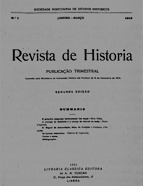

................................
Immediately, the signatories of the " circular-programme " focused on two main objectives: mitigating the damage caused by the "anti-historical revolution" following the 5 October event, as Fidelino de Figueiredo described in his essay Espírito Histórico (1910)—arguing that the revolution had caused an abrupt rupture with the past—and aligning Portuguese historical studies with the models prevalent in European countries that served as cultural references. This alignment fostered the development of comparative studies, an area in which Fidelino de Figueiredo was a significant proponent.
There are, however, limitations to a comprehensive study of this society. The primary gap in sources—and the most significant—is the absence of the minutes from regular meetings, which remain unlocated to this day. A set of five reports (mandatory under the statutes) provides some insight into the social life of the SPEH during its early years but unfortunately does not extend beyond 1915. Another limitation is the membership list, which does not cover the entirety of the SPEH’s existence, ending instead in 1920 .
The SPEH began its activities in 1911, though it did not acquire its premises until 1913. With a relatively simple organisational structure comprising a president, a board member, a secretary (a position consistently held by Fidelino de Figueiredo, who was responsible for drafting the Reports ), and a treasurer, the society quickly established itself in the cultural landscape of its time, especially regarding historical collections. Alongside regular sessions, during which members presented papers (many of which were later published as articles in the Revista de História ), the extraordinary sessions of 1912 proved particularly significant. That year, the SPEH issued an open "Manifesto" ( Revista de História , vol. I, pp. 49–51) addressing the issue of religious archives and libraries affected by the Law of the Separation of Church and State of 20 April 1911. A proposal was submitted to the Minister of Justice, António Macieira, presenting a systematic plan for the transportation and preservation of these collections, including the suggestion that some SPEH members assist in the process—a key point alongside the ideological considerations underlying the law. It should be noted that the rapporteur of this manifesto, the curator of the National Library of Lisbon, Pedro de Azevedo, also wrote brief notes on the matter, carefully separating the ideological issue from the historiographical work. To avoid creating tension, it was explicitly stated that the defence of these collections focused solely on their significance for historical research ( Revista de História , vol. I, pp. 51–53). However, in 1913, as a result of this vigorous defence, the Executive Commission of the Law, together with the command of the National Republican Guard, was ordered to summon the SPEH to surrender the keys to its premises. This did not occur and, almost ironically, the following year the SPEH gained greater prestige. On 9 December 1914, Sobral Cid, then Minister of Public Instruction, issued Ordinance No. 271, recognising the SPEH as a public utility and commending the Revista de História . The final designation of the SPEH can be identified in this ordinance, considering the other names it previously held ( A SPEH no contexto historiográfico nacional [The SPEH within a national historiographical context] p. 52). The ordinance highlighted the SPEH’s involvement in defending the archives and libraries of religious corporations, as well as its relations with foreign scientific communities. This attempt to shut down the SPEH is unsurprising, given the stance many of its members and collaborators held toward the Republicans, particularly the Democrats, with Fidelino Figueiredo being one of their main critics.
This work is financed by national funds through FCT - Foundation for Science and Technology, I.P, in the scope of the projects UIDB/04311/2020 and UIDP/04311/2020.
